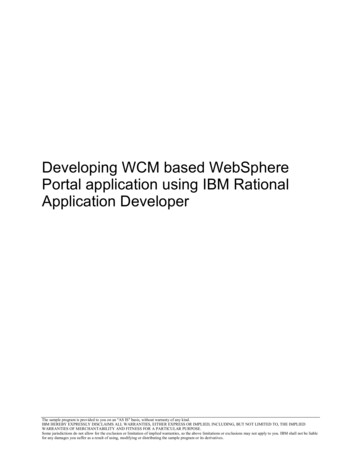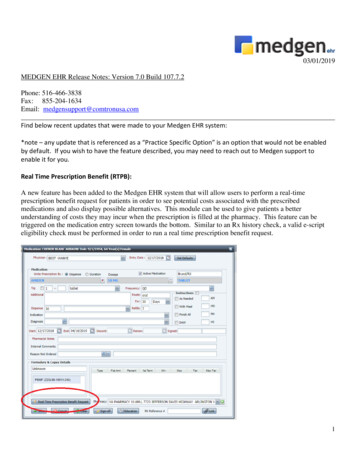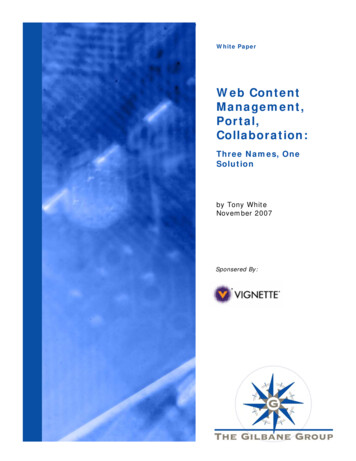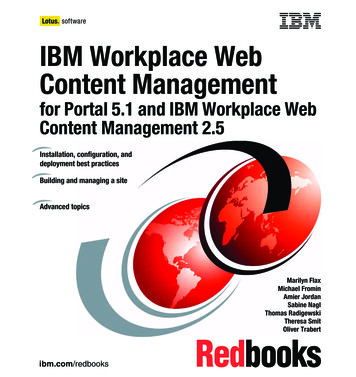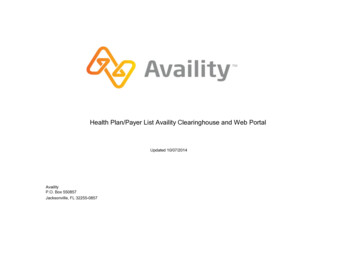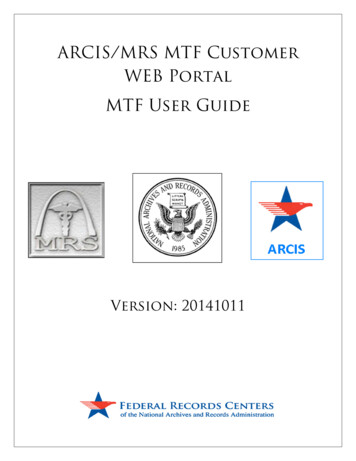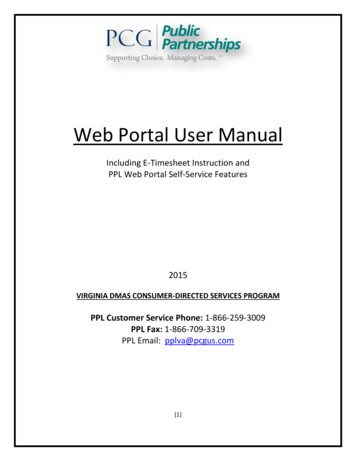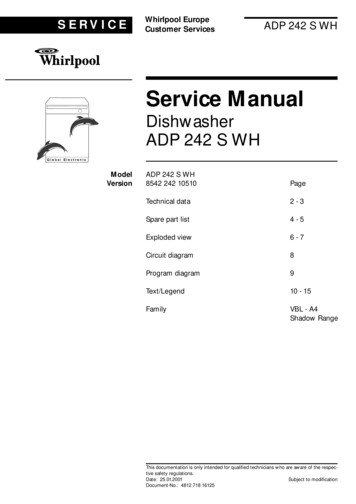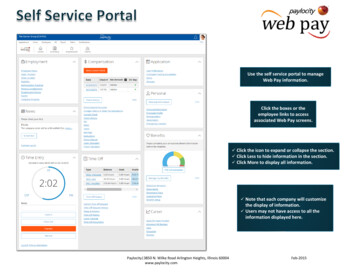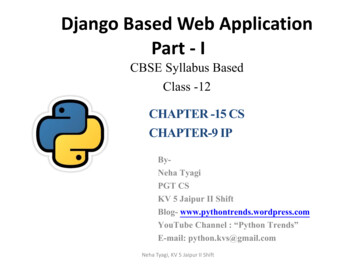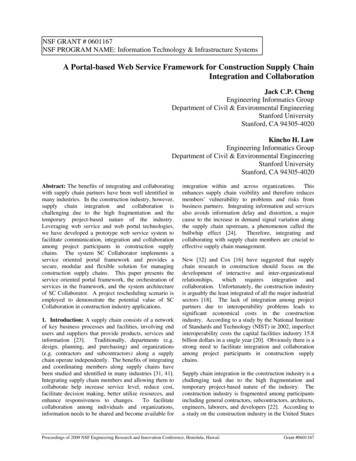
Transcription
NSF GRANT # 0601167NSF PROGRAM NAME: Information Technology & Infrastructure SystemsA Portal-based Web Service Framework for Construction Supply ChainIntegration and CollaborationJack C.P. ChengEngineering Informatics GroupDepartment of Civil & Environmental EngineeringStanford UniversityStanford, CA 94305-4020Kincho H. LawEngineering Informatics GroupDepartment of Civil & Environmental EngineeringStanford UniversityStanford, CA 94305-4020Abstract: The benefits of integrating and collaboratingwith supply chain partners have been well identified inmany industries. In the construction industry, however,supply chain integration and collaboration ischallenging due to the high fragmentation and thetemporary project-based nature of the industry.Leveraging web service and web portal technologies,we have developed a prototype web service system tofacilitate communication, integration and collaborationamong project participants in construction supplychains. The system SC Collaborator implements aservice oriented portal framework and provides asecure, modular and flexible solution for managingconstruction supply chains. This paper presents theservice oriented portal framework, the orchestration ofservices in the framework, and the system architectureof SC Collaborator. A project rescheduling scenario isemployed to demonstrate the potential value of SCCollaboration in construction industry applications.1. Introduction: A supply chain consists of a networkof key business processes and facilities, involving endusers and suppliers that provide products, services andinformation [23].Traditionally, departments (e.g.design, planning, and purchasing) and organizations(e.g. contractors and subcontractors) along a supplychain operate independently. The benefits of integratingand coordinating members along supply chains havebeen studied and identified in many industries [31, 41].Integrating supply chain members and allowing them tocollaborate help increase service level, reduce cost,facilitate decision making, better utilize resources, andenhance responsiveness to changes.To facilitatecollaboration among individuals and organizations,information needs to be shared and become available forintegration within and across organizations. Thisenhances supply chain visibility and therefore reducesmembers’ vulnerability to problems and risks frombusiness partners. Integrating information and servicesalso avoids information delay and distortion, a majorcause to the increase in demand signal variation alongthe supply chain upstream, a phenomenon called thebullwhip effect [24].Therefore, integrating andcollaborating with supply chain members are crucial toeffective supply chain management.New [32] and Cox [16] have suggested that supplychain research in construction should focus on thedevelopment of interactive and inter-organizationalrelationships, which requires integration andcollaboration. Unfortunately, the construction industryis arguably the least integrated of all the major industrialsectors [18]. The lack of integration among projectpartners due to interoperability problems leads tosignificant economical costs in the constructionindustry. According to a study by the National Instituteof Standards and Technology (NIST) in 2002, imperfectinteroperability costs the capital facilities industry 15.8billion dollars in a single year [20]. Obviously there is astrong need to facilitate integration and collaborationamong project participants in construction supplychains.Supply chain integration in the construction industry is achallenging task due to the high fragmentation andtemporary project-based nature of the industry. Theconstruction industry is fragmented among participantsincluding general contractors, subcontractors, architects,engineers, laborers, and developers [22]. According toa study on the construction industry in the United StatesProceedings of 2009 NSF Engineering Research and Innovation Conference, Honolulu, HawaiiGrant #0601167
[28], the top eight architectural, engineering andconstruction (AEC) companies control less than twentypercent of the market share while by contrast the topcompanies in the aerospace industry control overseventy-five percent of all trades within the industry.This is probably due to the fact that the constructionindustry is comprised of countless companies frommany different trades, most of which are small tomedium in size. These AEC companies tend to use awide range of hardware platforms and softwareapplications for their own operations, leading to thetechnical challenges in integrating the constructionsupply chains. The temporary project-based nature ofconstruction projects also hinders integration andcollaboration in construction supply chains. Sinceconstruction supply chains are highly dynamic, theorganizational structure changes frequently.It isunlikely for project participants to work together longenough on any one project to build enough trust, whichis necessary for organizations to become willing toshare information and systems. Therefore, the system tofacilitate integration and collaboration in constructionsupply chains should be widely accessible and scalablefor geographically distributed users, secure to helpestablish trust, and customizable and flexible to allowquick reconfiguration upon changes in supply chains.We have developed a flexible, scalable andcustomizable prototype web-based system forfacilitating integration and collaboration in AEC supplychains.The SC Collaborator system frameworkimplements web service technologies and serviceoriented architecture to provide modular developmentand flexible reconfiguration of system functionalities.Leveraging web portal technology, the frameworkoffers customizable system layout, secure accesscontrol, and a single point of access to multipleinformation sources and systems. Utilizing open sourcetechnologies, SC Collaborator provides an economicalsolution for AEC companies, usually reluctant orunaffordable to huge IT investment, to manage theirsupply chains.The paper is organized as follows: Section 2 describesthe shortcomings of the enterprise resource planningsystems for supply chain integration, and how they canbe solved using web service technology. Section 3presents the underlying service oriented portalframework, mechanisms to orchestrate services, andsystem architecture of the SC Collaborator system.Section 4 shows a scenario which illustrates thepotential of the SC Collaborator system to integrateloosely coupled information and applications amongmembers in construction supply chains.2. Integration of Information, Applications andServices2.1. Enterprise Resource Planning (ERP) Systems:An increasing number of AEC companies haveimplemented ERP systems to integrate loosely scatteredinformation and applications among stakeholders. AnERP system is typically employed in corporations tointegrate information including finances, accounting,human resources, supply chain, and customerinformation [17].They can potentially enhancetransparency along the supply chain by eliminatinginformation distortions and increase informationvelocity by reducing information delays [3].However, ERP systems were not designed and are oftennot suitable for the construction industry [46]. Thereare research studies and efforts on selection andimplementation of ‘generic’ ERP systems in theconstruction industry [2, 15, 35, 40, 46]. Companiesthat use a generic ERP system often need to modify andcustomize it to support their own needs, which is acostly process in terms of time, efforts and cost. Asmost AEC companies are small and medium businesses,they are reluctant to the huge implementationinvestment in information systems such as ERPsystems. In addition, the temporary and project-basednature of construction supply chains requires quicksystem deployments and frequent changes of tradingpartners.The inflexibility of ERP systems toaccommodate changes of supply chain structureshinders the usability and applications of those systemsin the dynamic, unstable construction supply chains.2.2. Web Service Technology: The Internet provides apromising channel to integration and collaborationamong geographically distributed individuals andorganizations. With the rapid development of webtechnologies, the Internet has become ubiquitous andinstantaneously accessible. The proliferation of theInternet makes it the most cost effective means ofdriving supply chain integration and information sharing[25].Today, AEC companies increasingly takeadvantage of the Internet and information technologyfor design and learning [12, 19, 34, 42], for documentand knowledge management [27, 48], and for projectmonitoring and management [8, 11, 14, 33].A web service can be described as a specific functionthat is delivered over the Internet to provide informationor services to users through application-to-applicationinteraction.Leveraging well established Internetprotocols and commonly used machine readablerepresentations, web services can be located, invoked,and combined to provide complex business services.The implementation of web services are encapsulatedProceedings of 2009 NSF Engineering Research and Innovation Conference, Honolulu, HawaiiGrant #0601167
and not exposed to the users. Therefore, changing theimplementation of one web service function does notalter the way that the users invoke the function. Thisenables clean and robust deployment and maintenanceof web services. Web services can be reused bymultiple applications or other services residing on anetwork, avoiding duplicated developments of serviceunits with similar functionalities.Web services are the building block of service orientedarchitecture (SOA). SOA is a system developmentmodel in which information sources and softwarefunctionalities are delivered as individual service unitsover a network. SOA allows a large complicatedsystem infrastructure to be built in a scalable manner.Modular system development and maintenance isenabled as the system is divided into web servicecomponents which can be managed separately. Quickreconfiguration and deployment is also allowed inservice oriented systems due to their plug-and-playcapability. This modularity and flexibility is crucial forinformation systems used in fast changing environmentssuch as the construction supply chains.3. Prototype Web Service Framework – SupplyChain Collaborator: Leveraging the web servicetechnologies, we have developed a prototype web-basedcollaborative system, called SC Collaborator (SupplyChain Collaborator). SC Collaborator is a systemdesigned for supporting AEC activities and integratingloosely coupled information and services. Based on aservice oriented portal framework which will bedescribed in Section 3.1, SC Collaborator implementsthe SOA approach and provides scalability, flexibility,customizability, single point of access, and extendablefunctionality. The service orchestration and systemarchitecture of the SC Collaborator system will bediscussed in the following sections. Figure 1 shows thehomepage of the SC Collaborator system for users tolog in.3.1. Service Oriented Portal Framework: Web portaltechnology provides a means to aggregate distributedweb services. A web portal is a web-based system thatacts as a gateway to a larger system or a network of webapplications. It provides a single point of access toinformation sources and application functionalitiesregardless of their physical location or storagemechanism. The basic operational units of a portalsystem are web portlets, which are sub-programs thatencapsulate a single or a number of web applications.Portal systems are necessary for web portlets to becomevisible and accessible. Portal systems enable multipleinformation sources and web applications to beretrieved and integrated into a workflow or a supplychain.Web portals are commonly used as an internalrepository of information and documents for datastorage, publication and retrieval within organizations[30]. Due to their customizability and security, webportals allow authorized users to access sensitivepersonal information and enable system administratorsto manage a huge amount of information in acentralized way.There is also a trend in theconstruction industry to establish project-specific webspace using portal systems for cross-organizationalcollaboration. However, there is little, if any, rigorousresearch on portal design, development, maintenance,and updating for facilitating supply chain managementdecisions [45]. The framework presented in this sectionis a service oriented approach for portal design andimplementation.A service oriented portal framework is a systemdevelopment framework that leverages web portaltechnology to provide a secure and customizable userinterface and implements SOA to integrate information,applications and services in a flexible and reusablemanner. In a service oriented portal framework, asillustrated in Figure 2, information sources, applicationfunctionalities and system operations are wrapped intoindividual web services, which can be located andinvoked by application portlet units via standardizedprotocol. These web services are integrated andorchestrated into different workflows for variousbusiness processes in the application portlet units.These web services can be reused in differentworkflows or reused multiple times in a singleworkflow. Therefore, development of repeated systemoperations is avoided. In addition, modification ofsystem functionalities becomes flexible and quick asevery business process is decomposed into separateatomic web service components.Figure 1: Homepage of the SC Collaborator systemProceedings of 2009 NSF Engineering Research and Innovation Conference, Honolulu, HawaiiGrant #0601167
App 1Source 1App 3WrapperWrapperWrapperWeb servicesWeb servicesApp 2WrapperWeb servicesWeb servicesSource 2WrapperApplicationto-applicationinteroperationWeb servicesApplicationPortlet UnitApplicationPortlet UnitPortlet gatewayPortlet gatewayFragmentsof HTMLApplicationPortlet UnitPortlet - portletinteractionPortlet gatewayFragmentsof HTMLFragmentsof HTMLService Oriented Portal SystemCentralizedmanagement andunified interfaceFigure 2: Conceptual framework for service orientedportal system3.2. Service Orchestration: In a service oriented portalframework, information, applications and internalsystem operations are deployed and delivered as webservices. These web services usually are not sufficientto perform a business process individually. These webservices are often needed to aggregate with each otherinto a workflow.For instance, multiple crossapplication activities are required to implement abusiness process “add purchase order.” These activitiesmay include adding a purchase order to the productionplan, sending confirmation to the customer, changingthe status of the order and the corresponding items, andallocating materials and resources to fulfill the order.Each of these activity components could be separatedand deployed as individual web services. A mechanismto combine these activity component services isnecessary to complete a business process. There areseveral research efforts on the mechanisms to invoke,terminate and combine web-based services [13, 21]. InSC Collaborator, the composition and orchestration ofthe web service units are performed using a modeldriven approach with the aid of process models residingon the business applications layer.Model driven approach allows system developers tounderstand and to check the systems easily through themodel representations. Model driven approach alsoenables system developers to transfer the models toanother system and to regenerate the implementationcodes. Therefore, it enhances the robustness andportability of system development and maintenance.Model driven approach has already been used forsoftware development for several years, but itsapplication on service orchestration is still under hotdiscussions and research in recent years [29, 38, 47].There are two major approaches for model drivenservice orchestration: (1) a top-down approach whichstarts with high-level semantic models such as UnifiedModeling Language (UML) [36] and Business ProcessModeling Notation (BPMN) [37] to executable code,and (2) a bottom-up approach in which proprietarymodeling is integrated within the IDE such as OracleBPEL Designer. In SC Collaborator, the top-downapproach is used because the high-level models areplatform independent and portable across varioussystems and applications.Each business task in SC Collaborator is associated witha single process flow model, represented in UML. Themodel describes the sequence of service units and thelogic involved during the transitions between the serviceunits. For example, interactions among the activitycomponents to complete the aforementioned businessprocess “add purchase order” can be represented in aUML model as illustrated in Figure 3.Forimplementation, the process flow model is convertedinto Business Process Execution Language (BPEL) [7],an emerging service orchestration standard fordescribing the behavior of web services at differentlevels of abstraction. BPEL is a layer on top of WebService Definition Language (WSDL) [9] and XMLSchema, with WSDL and XML Schema defining thestructural aspects of service interactions, and BPELdefining the behavioral aspects. Figure 4 shows anexcerpt of the BPEL file converted from the UMLmodel in Figure 3.Figure 3: UML activity diagram of the business process“add purchase order”Proceedings of 2009 NSF Engineering Research and Innovation Conference, Honolulu, HawaiiGrant #0601167
unified and customizable platform to supportinteractions between users and the system.Thebusiness applications layer provides an environment forexecuting various business processes such as decisionmaking and connecting to external data sources,applications and services. The extensible computinglayer is potentially comprised of numerous databases,software applications and web services that the businessapplications layer can integrate to support high-level orcomputationally intensive business functions.Open source technologies are leveraged to minimizeimplementation costs which hinder the usability in AECcompanies, which are usually small and medium in sizeand reluctant to huge investment in IT. In specific, opensource software Apache Tomcat [5], Liferay Portal [26]and MySQL [44] are used to support the communicationlayer, the user interface, and the database support. Opensource packages, such as Apache Struts [6], ApacheAxis [4] and Hibernate [39], are also utilized to supportthe communication channels and data mapping. In thefollowing sections, the components of SC Collaboratorare presented in detail.Figure 4: Excerpt of the BPEL file for the businessprocess “add purchase order”3.3. System Architecture of SC Collaborator: Figure5 shows the system architecture of the SC Collaboratorframework. The framework consists of an accesscontrol engine, a database support, and four layers ofintegrated functionalities – a communication layer, aportal interface layer, a business application layer, andan extensible computing layer. The communicationlayer provides a communication channel for users toaccess the system. The portal interface layer serves as a3.3.1. Communication Layer: A user-friendly andreadily accessible communication channel is essential tothe usability of a system. The SC Collaborator systemuses an open source platform – Apache Tomcat [5] – toenable the connectivity and access to the system.Apache Tomcat serves as a web servlet container for thecommunication servlets, Apache Struts [6] and ApacheAxis [4]. The Struts servlet allows users to access theSC Collaborator system using web browsers, which arecommonly available on every computer. The Strutsservlet also enables remote users to access the systemusing wireless devices via WAP protocol.Figure 5: System architecture of the SC Collaborator systemProceedings of 2009 NSF Engineering Research
A Portal-based Web Service Framework for Construction Supply Chain Integration and Collaboration Jack C.P. Cheng Engineering Informatics Group Department of Civil & Environmental Engineering Stanford University Stanford, CA 94305-4020 Kincho H. Law Engineering Informatics
